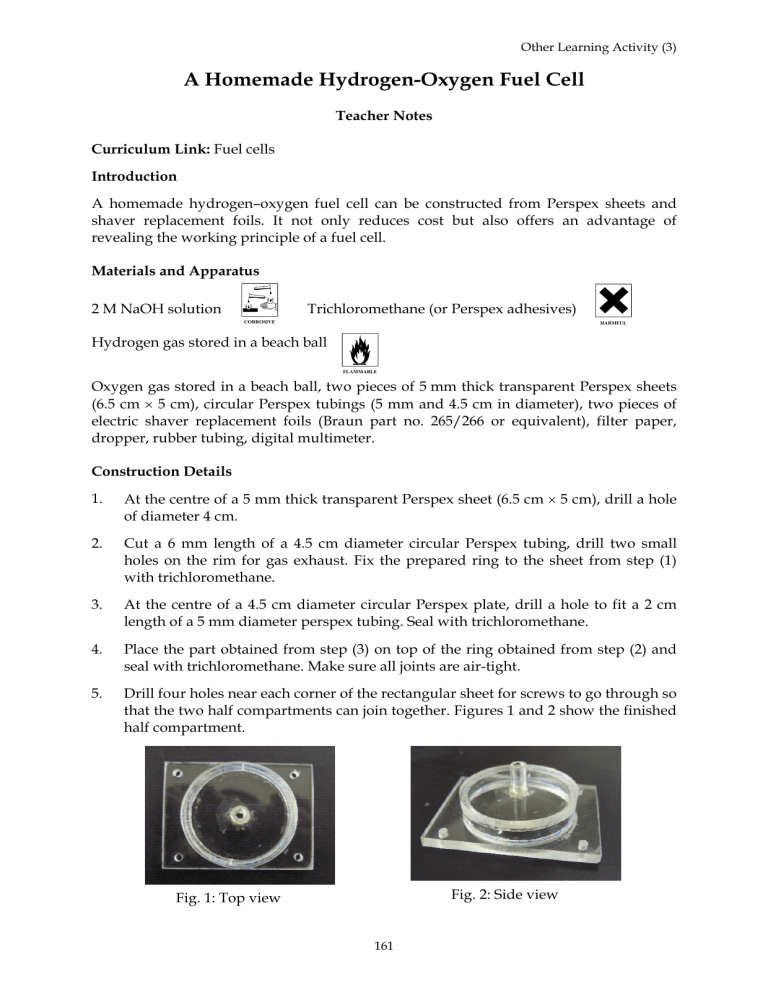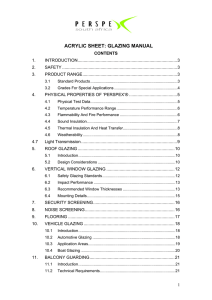A Homemade Hydrogen-Oxygen Fuel Cell

Other Learning Activity (3)
A Homemade Hydrogen-Oxygen Fuel Cell
Teacher Notes
Curriculum Link: Fuel cells
Introduction
A homemade hydrogen–oxygen fuel cell can be constructed from Perspex sheets and shaver replacement foils. It not only reduces cost but also offers an advantage of revealing the working principle of a fuel cell.
Materials and Apparatus
2 M NaOH solution Trichloromethane (or Perspex adhesives)
CORROSIVE
Hydrogen gas stored in a beach ball
HARMFUL
FLAMMABLE
Oxygen gas stored in a beach ball, two pieces of 5 mm thick transparent Perspex sheets
(6.5 cm × 5 cm), circular Perspex tubings (5 mm and 4.5 cm in diameter), two pieces of electric shaver replacement foils (Braun part no. 265/266 or equivalent), filter paper, dropper, rubber tubing, digital multimeter.
Construction Details
1. At the centre of a 5 mm thick transparent Perspex sheet (6.5 cm × 5 cm), drill a hole of diameter 4 cm.
2. Cut a 6 mm length of a 4.5 cm diameter circular Perspex tubing, drill two small holes on the rim for gas exhaust. Fix the prepared ring to the sheet from step (1) with trichloromethane.
3. At the centre of a 4.5 cm diameter circular Perspex plate, drill a hole to fit a 2 cm length of a 5 mm diameter perspex tubing. Seal with trichloromethane.
4. Place the part obtained from step (3) on top of the ring obtained from step (2) and seal with trichloromethane. Make sure all joints are air-tight.
5. Drill four holes near each corner of the rectangular sheet for screws to go through so that the two half compartments can join together. Figures 1 and 2 show the finished half compartment.
Fig. 1: Top view
161
Fig. 2: Side view
6. Repeat steps (1) to (5) to prepare another half compartment.
Other Learning Activity (3)
7. Cut two rectangular pieces of filter paper to fit the shaver foils (Fig. 3).
8. Sandwich two pieces of filter paper and two pieces of shaver foils between the two half compartments. Assemble the components together by screws and nuts. The finished product is shown in Fig. 4.
Fig. 3: A shaver replacement foil
Operation Procedures
Fig. 4: Finished fuel cell
1. Using a dropper, wet the filter paper of the fuel cell with 2 M NaOH solution.
2. Using rubber tubing, connect the outlet of the hydrogen beach ball to one side of the cell and the outlet of the oxygen beach ball to the other side.
3. Connect the two platinum plates to a digital multimeter (moving pointer multimeters do not offer enough input resistance for e.m.f. measurement). The electrode facing hydrogen gas is the negative pole. Press both balls slightly to release a steady stream of gases. Measure the e.m.f. of the cell. E.m.f. of an ideal hydrogen- oxygen fuel cell is +1.20 V.
Fig. 5: Measuring e.m.f. of a hydrogen-oxygen fuel cell
Reference
Lister, T. (1995). Classic Chemistry Demonstrations . London: The Royal Society of
Chemistry.
162







